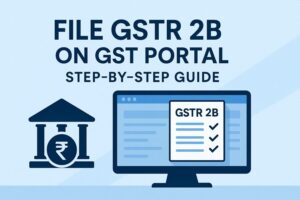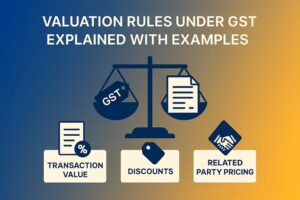Top 10 Features of Goods and Services Tax (GST) in India
- 2 Sep 24
- 10 mins
Top 10 Features of Goods and Services Tax (GST) in India
Key Takeaways
- Unified Tax System: GST replaces multiple indirect taxes with a single, streamlined tax structure.
- Destination-Based: Tax is collected where goods or services are consumed, benefiting the end-use state.
- Input Tax Credit: Businesses can offset taxes paid on inputs, lowering overall tax costs.
- Cost Efficiency: GST reduces production costs, enhancing the competitiveness of Indian businesses.
- Consumer Savings: Eliminating the tax-on-tax effect makes goods and services more affordable for consumers.
The Goods and Services Tax (GST), introduced in India on July 1, 2017, replaced a plethora of indirect taxes previously levied by both the Central and State Governments. It aims to streamline the tax regime, reduce complexities and promote a seamless flow of tax credits across the supply chain.
In this blog, we will explore the top 10 features of GST. From the intricacies of the tax structure to the benefits it offers to both Indian businesses and consumers, these features highlight one of the significant tax reforms in the country’s history.
How Does Goods and Services Tax (GST) Work?

The system of GST involves multiple stages. The six stages of Goods and Services are:
- Purchase of raw materials
- The production process
- Sending to warehouse
- Sale of goods to the wholesaler
- Sale of the finished goods to the retailer
- Selling of the goods to the final customers
Manufacturers buy raw materials to prepare a product. A warehouse agent then purchases it. He adds value, like packaging and labelling, and then sells it in small portions to retailers. The retailer then makes investments in marketing and promotion, which increases the value of the commodity. GST is applicable at every stage of value addition. The final stage is when the customer purchases the commodity from the retailer.
It is important to remember that you can levy GST at the place where the end-consumer acquires the goods or services, not the location of the manufacturer. If a good was manufactured in Mumbai but sold in Kolkata, the state government of West Bengal will collect the tax revenue.
Kinds of GST
There are four types of GST. Let us know about them in detail:
- CGST (Central Goods and Services Tax): Central Goods and Services Tax is applicable on transactions that take place within the same state or intrastate transactions. CGST Act governs this type of tax and the Central Government has the right to collect the revenue.
- SGST (State Goods and Services Tax): State Goods and Services Tax is levied on intrastate transactions. SGST Act governs this tax and the respective state government collects the tax revenue.
For instance: If a trader residing in Maharashtra sells goods to another trader in Maharashtra, then assuming the rate of GST is 18%, CGST and SGST will be divided equally with 9% each.
- IGST (Integrated Goods and Services Tax): Integrated Goods and Services Tax, on the other hand, is applicable in cases of interstate supplies. In other words, transactions that take place between different states. The IGST Act governs it. The responsibility lies with the Central Government to collect the tax revenue and distribute it between states.
For instance: If a trader residing in Maharashtra sells goods to a trader in West Bengal, then IGST will be levied on the transaction at a rate of 18%.
- UTGST (Union Territory Goods and Services Tax): Union Territory Goods and Services Tax is similar to SGST, the only difference is that it is applicable in transactions among union territories. Some union territories are Andaman and Nicobar Islands, Lakshadweep, etc. The UTGST Act governs the Union Territory Goods and Services Tax.
Objectives of GST
The objectives of Goods and Services Tax are:
- Unified Market: GST aims for tax evasion in India by combining various taxes under the same umbrella. It is a single tax that is applicable on the complete product lifecycle. This makes it easier to comply and helps to curb black money.
- Eliminates System of Tax-on Tax: One of the objectives of GST is to eliminate the cascading effect of taxes or double taxation. Additionally, under GST, one can also set off previous taxes of the same transaction by input tax credit.
- Decreases the Requirement for Multiple Documentation: GST also helps decrease the need for multiple documentation for taxes. This ensures simpler filing of returns, which further boosts efficiency and cuts down overall business costs.
Key Features of GST
The top ten salient features of GST have been discussed in detail, below:
- 4-tier Structure
GST comprises of four-tier tax structure, such as:
5%—essential commodities like life-saving drugs and food commodities
12%—commodities such as certain apparel items, medicines, etc.
18%—electronic gadgets and consumer durables
28% — Sin goods and luxurious products
- Input Tax Credit
One of the features of GST is the Input Tax Credit. Anyone who has GST and fulfils the necessary conditions is eligible to claim ITC. In businesses running under GST, tax is applicable at every stage of the supply chain. You can claim this tax as an input tax credit in the following stage.
- Destination-based Tax
GST is a destination-based tax. The reason is that the GST that is paid by the buyer on goods and services is not collected by the manufacturer but by the state government of the transaction. It significantly reduces the tax burden on business and tax is collected on every stage, which can be offset by claimant to ITC of the previous stage’s GST.
- Competitive Edge
The benefits of input tax credit and the elimination of the tax-on-tax system have allowed businesses to reduce their cost of production and ensure better GST compliance. This has provided a competitive edge in the international market and helped businesses attract a larger number of foreign buyers and investors.
- Composition Scheme
The composition scheme of GST allows eligible businesses to pay taxes at special rates on their turnover. There is also an availability of a special composition scheme for businesses with turnovers of not more than ₹50 lakh. However, businesses registered under the composition scheme can avail the special benefits of input tax credit.
- Dual Structure of Tax
GST operates as Central GST where the Central Government collects the tax revenues and State GST where the state government collects the tax revenues. In addition to this, there exists also IGST where the Central Government collects the tax and then distributes it between the states of the transactions.
- Online Portal
GST has an official Goods and Services Tax Network portal. It is of great help as it helps the concerned taxpayers to abide by their tax regulations online. This ensures digital compliance and streamlines the tax-paying process.
- National Anti-profiteering Authority
The National Anti-Profiteering Authority is an establishment by the government to pass on the benefits of GST to the customers. Competition Consumers of India deals with anti-profiteering complaints. The NAA supervises the activities of businesses and ensures that consumers do not engage in fraudulent activities and take undue advantage of the benefits of GST.
- Exemptions in Certain Sectors
GST not only reduces the rates for taxpayers in certain sectors but also exempts them from tax. Essentials like food grains, healthcare, education, etc. have exemptions or lower GST rates. This ensures better affordability, which in turn makes it more accessible to consumers.
- Tallying of Invoices
A system keeps a check on the tallying of invoices of both the supplier and the recipient. For instance, let us consider the supplier files the return of outward supplies, i.e., Form GSTR-1 return. If the details do not tally with the recipient’s GSTR-2B statement, which contains details of purchases, the GST portal will send automated notices.
Benefits of GST

Goods and Services Tax provides benefits to not only central and state governments but also to consumers. Let us learn about them in detail.
- For Central and State Governments:
GST has significantly increased the revenue collection of governments by subsuming various indirect like service taxes, value-added tax, etc. under one head. This led to the expansion of the tax base and efficient tax administration by the government.
The uniform tax structure has also reduced tax evasion by eliminating the cascading of tax. Thirdly, goods and services tax made the fiscal relationship between the central and state governments better, by encouraging cooperative federalism.
- For Consumers:
Before the implementation of GST, consumers had the burden of paying various types of indirect taxes. The simple tax reporting system has made it simpler and more transparent for consumers to understand better the calculation of tax they are paying.
The elimination of tax on the tax system is a great benefit to customers as this potentially lowers the price of goods, making them more affordable. The IT base of GST is also very strong. This helps consumers with filing returns and paying GST through net banking, Real Time Gross Settlement, National Electronic Funds Transfer, credit cards and so on.
Conclusion
It is essential to stay informed about the evolving features of GST and its updates as it helps you leverage the benefits of this tax system and optimise financial planning. The introduction of the Input Tax Credit (ITC), the GST Council and the online tax filing system has further enhanced business compliance.
With its far-reaching impact, GST remains a cornerstone of India's economic policy, fostering growth and development across various sectors.
💡If you want to pay your GST with Credit Card, then download Pice Business Payment App. Pice is the one stop app for paying all your business expenses.
 By
By 

















